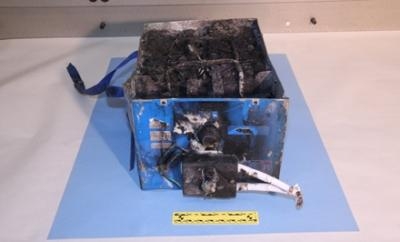Fri, May 23, 2014
Looks At The Power Cells As They Are Used In Aircraft Systems
The NTSB has issued a series of recommendations today related to the evaluation and certification of lithium-ion batteries for use in aircraft systems, as well as the certification of new technology.

The five safety recommendations, all addressed to the FAA, are derived from the NTSB’s ongoing investigation of the January 7, 2013, fire event that occurred in a lithium-ion battery on a Boeing 787 that was parked at Boston Logan Airport.
Investigators found that the battery involved in the Boston 787 fire event showed evidence not just of an internal thermal runaway but that “unintended electrical interactions occurred among the cells, the battery case, and the electrical interfaces between the battery and the airplane.”
The 12-page safety recommendation letter said that the processes used in 2006 to support the certification of the lithium-ion battery designed for the 787 were inadequate, in part, because there is no standardized thermal runaway test that’s conducted in the environment and conditions that would most accurately reflect how the battery would perform when installed and operated on an in-service airplane.
Further, the NTSB said that because there is no such standardized thermal runaway test, lithium-ion battery designs on airplanes currently in service might not have adequately accounted for the hazards associated with internal short circuiting.
In its examination of the challenges associated with introducing newer technologies into already complex aircraft systems, the NTSB said that including subject matter experts outside of the aviation industry “could further strengthen the aircraft certification process” by ensuring that both the FAA and the aircraft manufacturer have access to the most current research and information related to the developing technology.
To address all of these issues, the NTSB asked the FAA to do the following:
- Develop an aircraft-level thermal runaway test to demonstrate safety performance in the presence of an internal short circuit failure
- Require the above test as part of certification of future aircraft designs
- Re-evaluate internal short circuit risk for lithium-ion batteries now in-service
- Develop guidance for thermal runaway test methods
- Include a panel of independent expert consultants early in the certification process for new technologies installed on aircraft
The final report on the January 2013 Boston 787 battery fire investigation is estimated to be completed in the fall.
(NTSB image)
More News
Aero Linx: International Federation of Airworthiness (IFA) We aim to be the most internationally respected independent authority on the subject of Airworthiness. IFA uniquely combi>[...]
Ultrahigh Frequency (UHF) The frequency band between 300 and 3,000 MHz. The bank of radio frequencies used for military air/ground voice communications. In some instances this may >[...]
A Few Questions AND Answers To Help You Get MORE Out of ANN! 1) I forgot my password. How do I find it? 1) Easy... click here and give us your e-mail address--we'll send it to you >[...]
From 2019 (YouTube Edition): Learning To Paint Without Getting Any On Your Hands PPG's Aerospace Coatings Academy is a tool designed to teach everything one needs to know about all>[...]
Also: Sustainable Aircraft Test Put Aside, More Falcon 9 Ops, Wyoming ANG Rescue, Oreo Cookie Into Orbit Joby Aviation has reason to celebrate, recently completing its first full t>[...]
 ANN's Daily Aero-Linx (05.06.25)
ANN's Daily Aero-Linx (05.06.25) ANN's Daily Aero-Term (05.06.25): Ultrahigh Frequency (UHF)
ANN's Daily Aero-Term (05.06.25): Ultrahigh Frequency (UHF) ANN FAQ: Q&A 101
ANN FAQ: Q&A 101 Classic Aero-TV: Virtual Reality Painting--PPG Leverages Technology for Training
Classic Aero-TV: Virtual Reality Painting--PPG Leverages Technology for Training Airborne 05.02.25: Joby Crewed Milestone, Diamond Club, Canadian Pilot Insurance
Airborne 05.02.25: Joby Crewed Milestone, Diamond Club, Canadian Pilot Insurance



